A Quora question inspired this post. Someone wanted to know why water is important for a cat. Here you will read several cat health benefits that relate directly to how much water your cat drinks.
Cats And People Mostly Made Of Water
Just as with humans, cats need a great deal of water, because their bodies are about 2/3 water. Hard to believe, but water becomes essential to keep the cat from dehydration.
If cats become dehydrated, it can lead to several health problems: bladder inflammation and urinary diseases, including kidney disease and feline lower urinary tract diseases, tumors, ruptured bladders, and stones.
Water Encourages Health
Your cat can avoid these serious conditions if he remains hydrated by drinking sufficient amounts of water. Water has an essential role as a nutrient for your cat: Important for life, health, and vitality.
- Water forms the main constituent of cells, tissues, and organs
- Water has the role of lubricant and shock absorber
- Water forms the transportation systems of the body
- Water keeps the vascular balance and allows blood to circulate
- Water transports nutrients and removes wastes
Every aspect of kitty’s body depends upon adequate water hydration in order to function effectively. Therefore, why do 80% of cats in the United States get fed dry food? Their “parents” must not realize the importance of water.
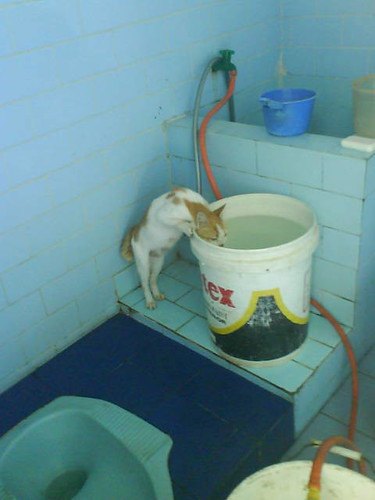
Dry food has so little moisture that it actually robs kitty’s body of moisture in order to metabolize the food’s nutrients. How can such a food have the label of “Complete and Balanced?”
It is good to have an awareness that even mild dehydration can become a risk factor in the progress of all types of chronic diseases. Evidence actually shows that increasing hydration can have a role in helping to prevent these diseases.
Number One Cause Of Death
Chronic kidney disease now ranks number one in the causes of death in cats over five years of age. It ranked near or at the top for the reason for visits to the vet in many cases.
The cat health industry should emphasize more strongly the need for water for all cats, as it is a vital nutrient. Often, pet owners simply do not understand just how much water the cat needs.
The original cats were desert animals who rarely drank water. Their fresh food diet of prey added a great deal of water, as prey had a 70 to 80% moisture content.
If you feed your cat solely on dry food, he/she will have a lower water intake and lower urine volume than cats who eat wet food, even when the cat has constant access to fresh water.
Food Moisture Levels Important
According to the Nutrition Research Council, which supplies the nutritional requirements on which AAFCO bases their information, a cat can maintain his hydrated state as long as the moisture level in the food meets or exceeds 63%. A cat becomes dehydrated at 61%.
Look at these levels:
Dry Food Moisture content 6 to 10%
Canned Food Moisture content 65 to 75%
Raw Food Moisture content 70 to 80%
Thus, if you feed your cat canned or raw food and no dry food, the cat gets plenty of water. However, remember that hyperthyroidism, diabetes, and kidney disease greatly increase a cat’s daily water requirements.
Now you can see that a kibble-only diet creates a state of chronic dehydration unless your cat consumes a lot of additional water.
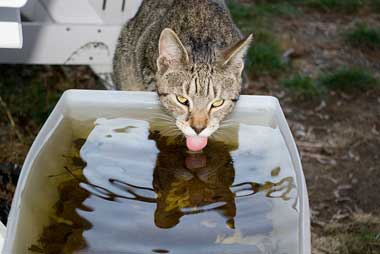
Now I can understand why my old Pogo cat, before he came to live with me, had so many urinary tract infections. I think he just didn’t consume enough water. When he moved to my house, I found a couple of water dishes he really liked, and gave him fresh water in them every day. He got only wet food, though at his other home, he’d had a serving of dry food and a little bit of wet food added.
Kittens And Water
What about kittens? Just as with an adult cat, clean, fresh water should be available to a kitten 24/7. If the kitten needs surgery, give him water the night before, even if not recommended. The kitten should have access to water until an hour or two before the procedure.
Possibly, the vet may hydrate the kitten either with intravenous or subcutaneous fluid administration. Then, after the kitten comes home, if you observe that he produces urine regularly, it means the baby cat now has become properly hydrated.
Shortage of water for the kitten or excessive loss of water, which might occur in a situation like excessive heat, makes it imperative that you make sure the kitten drinks. If the baby overheats, he may pant, which helps with cooling, bot water becomes lost from the lungs in this process. It becomes most important in hot weather to make sure your kitten has a supply of water constantly.
If sufficient water does not get supplied in enough quantity, excessive heat as well as some metabolic disorders can very quickly cause the kitten to die.
The Subcutaneous Solution
Sometimes a cat needs some added help to get enough water in his system, and in such a case, your vet may suggest giving subcutaneous fluids under kitty’s skin. He can show you how to give such fluids. When Pogo was headed toward dehydration, our vet gave him fluids in this way, and it really helped the cat.
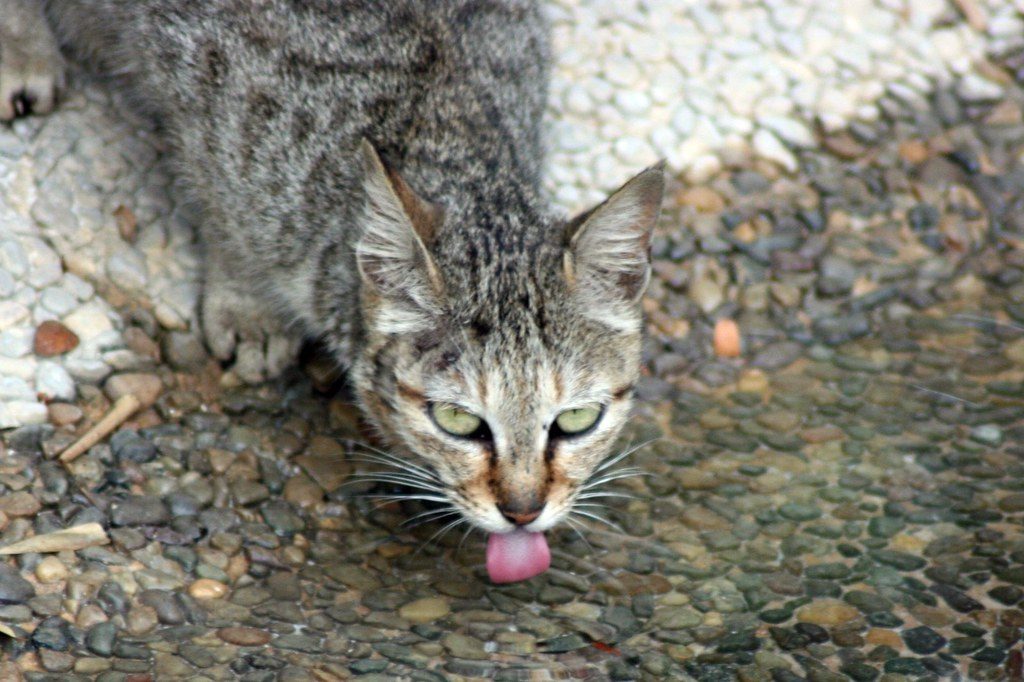
Tips For Changing Kitty’s Food
You’d think all cats would love to switch to canned foods in place of kibble. It’s often not the case. If your cat doesn’t want the wet food and wants his familiar kibble, you may cause him undue stress by trying to get him to change. Try these ideas first:
- Mix just a small amount of the canned food with his dry food, and over a week or two, gradually increase the amount of canned food. Any time you need to make dietary changes, gradual is the way to go. Sudden changes can cause vomiting and/or diarrhea.
- It won’t harm the cat to be hungry, though he may tell you otherwise. If he refuses the canned food, take away all his dry food and offer the canned food only, 12 hours later. Leave it out for a few hours. If your cat still won’t eat, give a small meal of dry food, but don’t leave any extra out. Repeat the process every 12 hours.
- Give it a few days, and if it doesn’t work, try sprinkling a little irresistible treat on top of the canned food. You might crush a few treats or dry kibble, a taste of tuna, some kind of cheese kitty likes, for example. You can try a less-healthy canned food temporarily — it may have ingredients that the cat can’t resist.
Don’t Let Kitty Skip Too Many Meals
If the cat doesn’t respond, don’t let her skip too many meals, as it could furnish a health risk. If a cat’s fat becomes mobilized too quickly, it can lead to a potentially fatal disease called hepatic lipidosis.
If your vet puts your cat on a prescription diet, ask if it is available in a dry form. Perhaps adding some of the dry food will encourage the cat to eat.
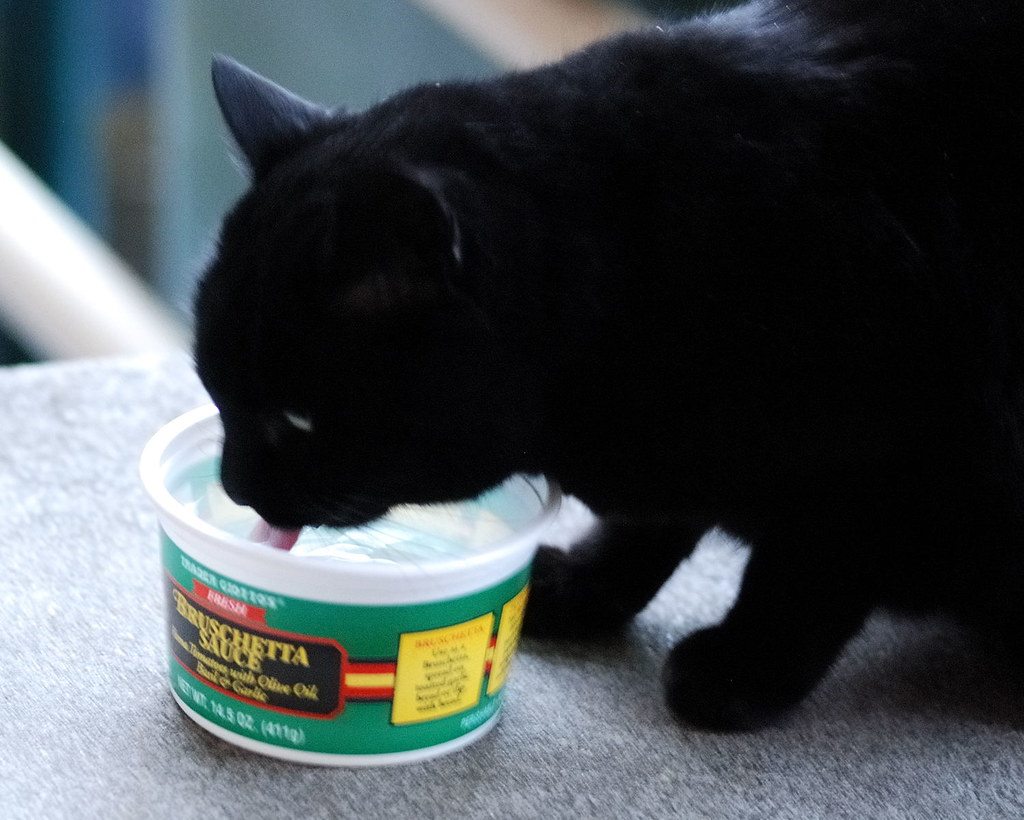
The Drinking Container Is Important
Find out what kind of container your cat prefers to drink from. Put several around the house and observe. I did this with Pogo, and his favorite was a low-sided individual casserole dish, long and narrowing at the end. He had plenty of room for his whiskers, which is important to consider with bowl selection, and for some reason really preferred that container.
The container in this picture looks like it might be plastic. Either ceramic or glass make better choices for water containers, but kitty will find fresh water in novel spots.
Another possibility: You can leave a faucet on at a fast drip, several times a day. Or, buy a kitty water fountain to encourage him to drink. As cats prefer fresh, running water, the fountain may prove to be the best solution.
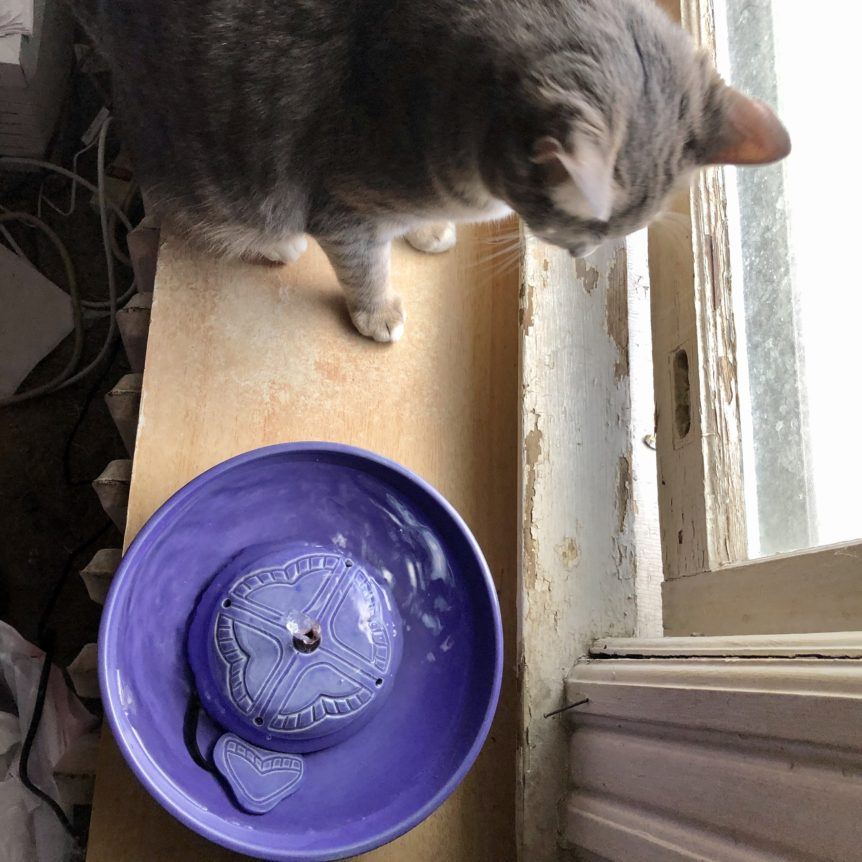
Getting your kitty to drink sufficient water will help a great deal with keeping him healthy. Also, it will improve his chances of not contracting chronic kidney disease or other serious health problems.
Though living creatures, including cats, can go for some time between meals, none of us can go long without water. Water, for cats and for humans, enhances health and life itself. Therefore, it provides an essential ingredient to the body that must come from water intake, so make sure you and your cat both get enough water.
References I used for this post: foodfurlife.com/water---the-essential-nutrient.html#1 petplace.com/article/cats/pet-care/why-is-water-important-for-cats/ hillspet.com/cat-care/nutrition-feeding/drinking-water-can-save-your-cats-bladder figopetinsurance.com/blog/fluids-benefit-cats-kidney-disease petmd.com/blogs/fullyvetted/2011/dec/importance_of_water-12189

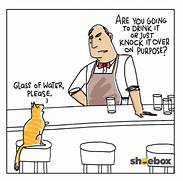
A low ceramic bowl, heavy enough not to knock over, is ideal. I’ve also had cats that liked coffee mugs. I kept 3 around the house in Kodiak, but that was before I know the dangers of dry food. Now my kitties only get wet and never want water. And wow can they pee!
Excellent! Yes, your idea on the water bowl is ideal. Glad you are now a wet-food person. I knew wet food was better, but did not realize until doing research for this article how bad dry food can be. I’m educating myself by writing!